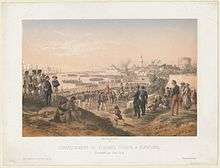Battle of Eupatoria
The Battle of Eupatoria (Russian: Штурм Евпатории (Storm of Eupatoria), Turkish: Gözleve Muharebesi) was the most important military engagement of the Crimean War on the Crimean theatre in 1855 outside Sevastopol.
| Battle of Eupatoria | |||||||
|---|---|---|---|---|---|---|---|
| Part of the Crimean War | |||||||
 The charge of the French cavalry during the battle of Eupatoria, by Adolphe Yvon | |||||||
| |||||||
| Belligerents | |||||||
|
|
| ||||||
| Commanders and leaders | |||||||
|
|
| ||||||
| Strength | |||||||
|
30,000-strong Ottoman garrison (4 infantry divisions, 1 cavalry regiment and around 100 pieces of artillery) 3 French cavalry regiment and a horse artillery battery At sea: 4 British steamers of the line, 1 Ottoman and 1 French steam frigates. | Between 20,000 and 30,000 (36 infantry battalions in 4 divisions, 6 cavalry regiments and 108 pieces of artillery) | ||||||
| Casualties and losses | |||||||
| 415 killed or wounded |
168 killed (including 4 officers) 583 wounded (including 1 general, 42 officers) | ||||||
Battle

The Siege of Sevastopol by French, Ottoman and British units became the focus of the Crimean War from October 1854. The Ottoman Empire started to transfer more forces from the Danube front to the Crimean port of Eupatoria and the town was being fortified. Upon direct orders from Emperor Nicholas I of Russia, who feared a wide-scale Ottoman offensive on the Russian flank, the Imperial Russian Army assembled an expeditionary force under the command of General Stepan Khrulev, aiming to storm the Allied base with a force variously estimated between 20,000 and 30,000.
Khrulev hoped to take the Ottoman garrison by surprise and attacked on 17 February 1855 (N.S.). His intention failed to materialise, as both the Ottoman garrison and the Allied fleet anticipated the attack.
Heavy Allied artillery fire countered the Russian artillery and infantry attacks. Failing to make progress after three hours and suffering mounting casualties, Khrulev ordered a retreat.
This Russian reverse led to the dismissal of the Russian Commander-in-Chief Alexander Sergeyevich Menshikov (February 1855) and probably hastened the death of Nicholas I, who died on 2 March 1855 (N.S.).
Strategically, the battle confirmed that Allied total command of the sea would ensure that the threat to the Russian flank would remain for the duration of hostilities. For the Allies, possession of Eupatoria meant that the total investment of Sevastopol remained a viable option. The Russians could not afford to commit unlimited resources from their vast army to the Crimean Peninsula for fear of a lightning Allied thrust from Eupatoria closing the neck of the peninsula at Perekop.
The Ottoman Army had regained its self-esteem and to some extent its reputation; most French and British realised this, although others (including the high command) would stubbornly refuse to make further use of Ottoman fighting abilities in the Crimean theatre.
References
- Blake, R. L. V. ffrench, The Crimean War (Sphere Books; London: 1973)
- Barham, John, Bono, Johnny Turk! (Article in Suite101 )